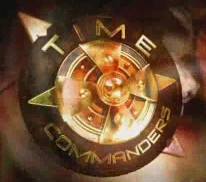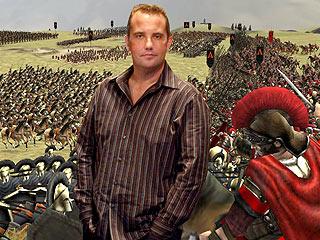Time Commanders
Contents |
Host
Eddie Mair (2003-4)
Richard Hammond (2005)
Gregg Wallace (2016)
Co-hosts
Historical experts:
Aryeh Nusbacher (all episodes, from 2016 as Lynette Nusbacher)
Adrian Goldsworthy (rotation, 2005)
Mike Loades (rotation, 2003-5, all episodes 2016)
Saul David (rotation, 2003-5)
Mark Urban (rotation, 2003-5)
Voiceover: David McAlister (2003-4)
Broadcast
Lion Television for BBC Two, 4 September 2003 to 13 March 2005 (24 episodes in 2 series)
Lion Television for BBC Four, 12 to 27 December 2016 (3 episodes in 1 series)
Synopsis
Just scraping into the definition of game shows, Time Commanders pits a team of four armchair generals against the might of a computer simulation. There are no prizes, other than the satisfaction of a job well done.
The set is like something out of the Industrial Zone of The Crystal Maze. It's a converted warehouse, with a gantry running above the room. The main area itself is split into two levels, one about six feet higher than the other; at the lower end sits two computers, and above those machines, a large video display wall. Laid into the higher level is an illuminated podium, on which a map of the area will appear. The teams also have some coloured blocks to indicate troop patterns, and a poker rake with which to move them.
Eddie Mair is our host. He's a genial Scottish radio announcer, making his first regular appearance on national television. With a swift wit and friendly banter, he sets the contestants at ease, explains the scenario, then lets the team cock it up for themselves.
The game runs a little bit like this. Our team of four command an army, doing battle against Ancient Rome. (It is always Ancient Rome, the producers lost the rights to Athens and Troy to Sky and ITV, and most newer battles are still under copyright.) Eddie Mair talks the team through the terrain, and they place their troops in an initial battlefield formation. Some outriders scout the opposition, giving a glimpse of where the foes might be. The team talks tactics, and battle begins a little under halfway through the hour-long programme.
And it's the battle that makes the show. The game engine from computer game Total War has been tweaked and prodded to provide a decently realistic view of the game. The CGI interface shows real CGI warriors (in blue) battling with real CGI Romans (in red), and spilling real CGI blood. Well, just falling down on the ground and not moving in long shot is quite sufficient, but this is realistic stuff. There are some pans and swoops around the battlefield, in a way that only created imagery can provide. So far as we can tell, the Total War engine has been set with appropriate parameters and a strategy the Romans might have used, and then left to its own devices.
Back in the real world, two of the team are on the upper level, looking at a view of the battle on the video wall, and pushing around those little blocks of their army on the map. The other two are too close to see the big board, they're concentrating on fighting their own little battles, giving orders to a technician (in black baseball cap, naturally) to tap into the computer. These generals on the field hear orders from their commanders at the top, closely mimicking a real battlefield situation.
Inevitably, the whole thing disintegrates into some sort of farce most weeks, with the strategy falling apart, or the Romans coming up with some very clever wheeze that the team hadn't anticipated, or the field generals misinterpreting the commander's orders. There are no dea ex machina, all the clues to win the game are contained in the introductory half.
After about twenty five minutes of play, one side or another is nearing defeat, and this brings up the one tacky moment on the show: the words "Defeat Imminent" or "Victory Imminent" appear in big bold lettering on the screen, sirens blare, lights start to flash, and the whole show heads downmarket for a little while.
Once the battle has been lost (or won, it does happen from time to time), Eddie Mair rejoins the teams to commiserate. Dr Aryeh Nusbacher (later Lynette) and another expert have been watching the show from the gantry, and have made a few quiet comments to camera from time to time. Now, and only now, do they come down, meet the teams, and explain just how the Romans would have done it, and how they might have been beaten in the real battle. This is how they programmed the Total War engine, and this is how to beat it.
The voice-off during the battle and the scene-setting belongs to David McAlister - his sonorous tones add a touch of gravitas to the show, ensuring it doesn't risk getting bogged down in a mixture of cheeriness and bonhomie. This is a war show, having presentation that's too chirpy feels wrong.
At the end of the day, we've learned that war is a bloody business, that the Romans aren't always unbeatable (if they were, they would never have lost their Empire), that sometimes you'll win by being clever, other times you need to be very, very lucky, so do wrap up.
Revival
The 2016 revival saw a few changes, most significant of which was that the games were now head-to-head battles between two teams, rather than one team versus the computer. They also got to practice with a "skirmish" ahead of the main event, and during the battle each team had the option of a single three-minute "time out" which they could use to call on the advice of the historical experts. We also got informative, though somewhat stilted, filmed inserts with Mike Loades and his team demonstrating (for real) the key weapons used in the battle. In an unusually modern twist (and a nod to a battle yer average punter will have heard of), one of the episodes was a recreation of the 1815 Battle of Waterloo.
Key moments
In the early episodes, the "generals" had to follow the action by pushing blocks around on a map. Inevitably, they would fail to keep up with what was happening on the big screen and completely lose track of the action, which was always amusing to watch. About halfway through the first series, though, the blocks were edged out in favour of a real-time computer projection - less fun, but more fair.
The relish and (sometimes over) enthusiasm of the experts as they explained what really happened was often at least as entertaining as the actual game. The most memorable explanation was probably when they decided to illustrate a barrage of arrows being fired at one side (or some such) to soften them up by throwing cocktail sticks at the relevant coloured blocks.
Inventor
Adam MacDonald
Merchandise
Time Commanders: Great Battles Of The Ancient World (paperback book)
Web links
Opening titles from the BBC Motion Graphics Archive



